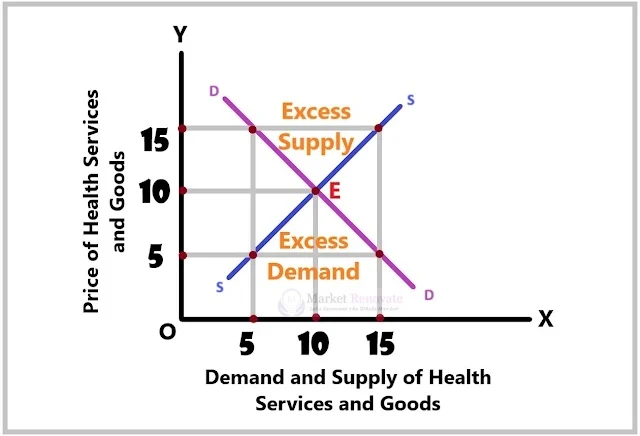Equilibrium in Public Health Demand and Supply Market
In health economics, the concept of equilibrium in the public health demand and supply market refers to a state in which the quantity of healthcare services demanded by the population matches the quantity of healthcare services supplied by healthcare providers. This equilibrium point is determined by the interaction of the demand and supply curves for healthcare services.
- Demand for Healthcare Services: The demand for healthcare services is influenced by various factors, including the population’s health needs, preferences, income levels, and access to healthcare. As the price of healthcare services (which could be monetary or non-monetary, such as time and effort required to access care) changes, the quantity demanded by the population also changes. Generally, the demand curve for healthcare services slopes downward, indicating that as the price of healthcare services decreases, the quantity demanded increases.
- Supply of Healthcare Services: The supply of healthcare services is determined by factors such as the number of healthcare providers, their capacity to offer services, the availability of medical facilities, technology, and the cost of providing care. As the price of healthcare services changes, healthcare providers may adjust the quantity of services they are willing to supply. Typically, the supply curve for healthcare services slopes upward, suggesting that as the price of healthcare services increases, the quantity supplied also increases.
At the equilibrium point, the quantity of healthcare services demanded by the population equals the quantity of healthcare services supplied by healthcare providers. This point is where the demand and supply curves intersect. When the market is in equilibrium:
- Excess Demand: If the price of healthcare services is below the equilibrium price, there will be excess demand. This means that more people want healthcare services than can be provided at that price. This situation could lead to longer wait times and potential rationing of care.
- Excess Supply: If the price of healthcare services is above the equilibrium price, there will be excess supply. This means that healthcare providers are offering more services than people are willing to pay for at that price. This might lead to healthcare providers reducing their prices or offering additional services to attract more patients.
We can understand the concept of Equilibrium in the public health demand and supply market with the help of following table and diagram:
| Price of Health Services and Goods (In Rs.) | Demand for Health Services and Goods (In Units) | Supply of Health Services and Goods (In Units) | Remarks |
| 5 | 15 | 5 | Excess Demand |
| 10 | 10 | 10 | Equilibrium |
| 15 | 5 | 15 | Excess Supply |
The table presents a depiction of the relationship between the price of health services and goods in Rs., the corresponding demand and supply quantities in units, and the resulting market conditions. At a price of Rs. 5, there is excess demand as 15 units are demanded while only 5 units are supplied, indicating a shortage.
At a price of Rs. 10, equilibrium is achieved with 10 units demanded and supplied, signifying a balanced market state. Conversely, at a price of Rs. 15, there is excess supply as 15 units are supplied while only 5 units are demanded, resulting in a surplus. This table underscores the dynamic interplay between demand and supply at different price levels in the market for health services and goods.
In the above diagram, we can observe that at a price of Rs. 5, a condition of excess demand emerges, wherein the demand for 15 units surpasses the supply of 5 units, indicating a deficit in availability. At a price of Rs. 10, equilibrium is accomplished with both 10 units demanded and supplied, symbolizing a harmonious market equilibrium (E). In contrast, at a price of Rs. 15, there exists excess supply, as 15 units are available while only 5 units are sought after, leading to an abundance.
The upward sloping supply curve (SS) and downward sloping demand curve (DD) intersect at point E, which is the equilibrium point. Above this point, there will be excess supply and below this point, there is excess demand. It means that, all other things remaining constant, the public health market will be in equilibrium at at point where public health market demand curve intersects public health market supply curve.






Please leave your comments or ask your queries here. The comments shall be published only after the Admin approval.